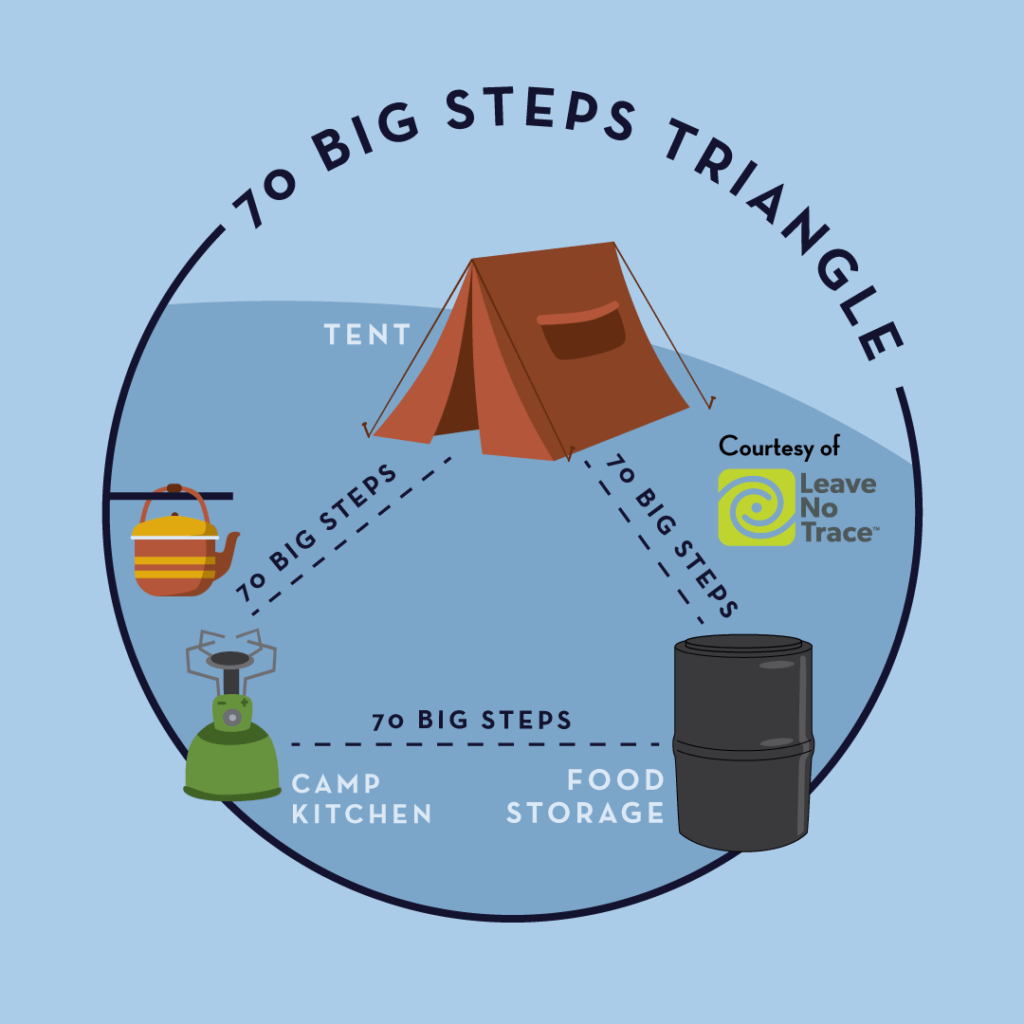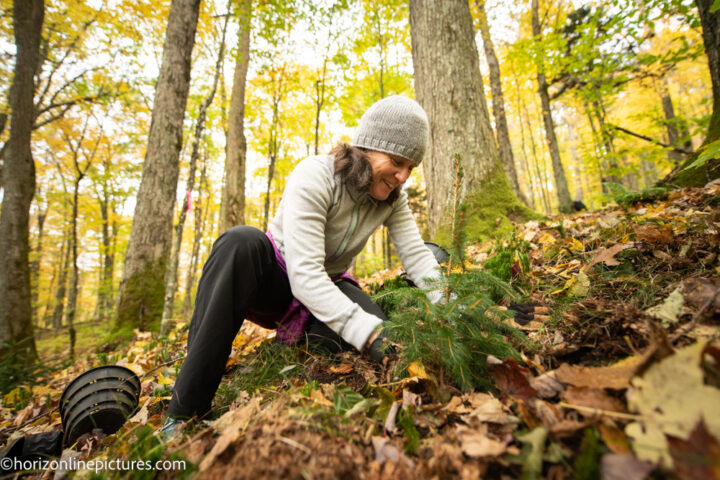Decoding the Appalachian Trail: Leave No Trace Edition
April 11, 2024
Navigating the Appalachian Trail (A.T.) comes with its own lexicon, especially when it comes to preserving the Trail through Leave No Trace principles. You may know the seven Leave No Trace principles (Plan Ahead & Prepare; Travel & Camp on Durable Surfaces; Dispose of Waste Properly; Leave What You Find; Minimize Campfire Impacts; Respect Wildlife; Be Considerate to Other Visitors), but there are several other terms and phrases that are helpful to understand.
Having a solid understanding of Leave No Trace is essential for any visitor to the A.T., from day hikers to thru-hikers! Here’s a breakdown of some common terms associated with Leave No Trace:
Alpine zone/sub-alpine zone: High-elevation environments characterized by harsh conditions and fragile, unique flora and fauna usually only found in the arctic. Respecting regulations and guidelines specific to alpine and sub-alpine zones is essential for minimizing environmental impact in these fragile ecosystems, such as staying on trails and not camping above treeline (where trees are 8’ tall or shorter).

Alpine bilberry is a low-growing alpine shrub that can be found on northern sections of the A.T.

Bear-muda triangle: A humorous term describing the triangular area formed by the campsite, food storage, and cooking area all being 200 feet apart from one another. That way, if a bear comes to investigate where you cooked or stored your food, your tent will still be a safe distance away.
Biodegradable: Refers to materials that can naturally decompose over time without leaving harmful residues. While biodegradable items may seem harmless, they still need to be disposed of properly to prevent potential harm to wildlife and ecosystems. Did you know that an orange peel can take over two years to fully decompose? Remember to pack out peels, pits, and other “biodegradable” waste.
Cathole: A small hole, 6-8 inches deep, dug for burying human waste in areas without toilet facilities. Proper cathole digging and waste burial are essential to prevent contamination of water sources and minimize human impact on the environment. Only poop and toilet paper should go in catholes – always pack out wipes, menstrual products and other trash!

All A.T. visitors should pack a trowel to dig a cathole when nature calls.
Durable surfaces: Refers to surfaces, such as established trails, already impacted campsites on bare soil, rocks, or gravel, that can withstand human activity without sustaining damage. Traveling and camping on durable surfaces help minimize soil erosion, vegetation trampling, and habitat destruction.
Earshot: The distance within which sounds can be heard clearly. Being mindful of noise pollution and keeping activities quiet helps minimize disturbance to wildlife and other visitors in natural areas.
Greywater: Wastewater generated from activities like dishwashing, bathing, or laundry that doesn’t contain human waste. Proper disposal of greywater involves dispersing it at least 200 feet away from water sources and minimizing its environmental impact.
Habituation: The process by which wildlife becomes accustomed to human presence and behavior, potentially leading to negative interactions or dependency on human food sources. Minimizing habituation is essential for preserving the natural behavior and safety of wildlife.
Human browse line: The height at which vegetation and trees shows signs of damage caused by human activity, usually campfire building. Practicing Leave No Trace campfire building (or forgoing a campfire altogether) helps preserve the natural aesthetics and ecological balance of overnight sites on the A.T.
Impacted area: Portions of wilderness or outdoor spaces that have experienced significant human disturbance or degradation. Rehabilitating impacted areas through restoration efforts helps restore natural habitats and ecological processes.
Land manager: Individuals or organizations responsible for overseeing and managing public lands, such as national parks, forests, wilderness areas, and state lands. Working with land managers helps ensure responsible recreational use and conservation efforts.
PCT Hang: A method of hanging food and other smellables out of reach of wildlife, commonly used by backpackers on the Pacific Crest Trail (PCT) and other wilderness areas to prevent attracting bears and other animals. All bear hangs on the A.T. must be at least 12’ up and 6’ away from the tree trunk and closest branch. A.T. Hikers should use a PCT hang if they are not using a bear canister (check out the vide below to learn how). The ATC highly recommends using a bear canister while backpacking on the A.T.
Right-of-way: The privilege of precedence or passage granted to individuals or groups in certain situations, such as yielding to uphill hikers on narrow trails or giving way to wildlife to avoid disturbances. Respecting right-of-way ensures smooth and courteous interactions between outdoor enthusiasts.
Riparian zone: The area of land adjacent to rivers, streams, or other water bodies, characterized by unique vegetation and ecological features. Protecting riparian zones by camping and disposing of waste at least 200 feet away is vital for maintaining water quality and supporting diverse wildlife habitats.

Image courtesy of Great Smoky Mountains National Park
Rule of thumb: In the context of Leave No Trace, the rule of thumb may refer to a technique for making sure you’re giving wildlife enough space. If you can hold up your thumb and still see the animal, you’re too close!
Smellables: Items with odors that can attract wildlife, such as food, toiletries, or scented items. Proper storage and disposal of smellables are essential for preventing wildlife encounters and maintaining the natural behavior of animals. Besides food trash, common smellables on the A.T. include cookware, chapstick, sunscreen, bugspray, lotion, and some medications.
Social trail: Unofficial paths formed by repeated foot traffic, often created when hikers veer off designated trails. Avoiding social trails helps protect fragile ecosystems and preserve the integrity of established routes.
WAG bag: Short for Waste Alleviation and Gelling bag, a portable, disposable toilet system designed for human waste management in the outdoors. WAG bags are often used in sensitive environments where catholes are impractical or prohibited, like above treeline in the White Mountains of New Hampshire and the high peaks of Maine.
By familiarizing yourself with these terms and integrating them into your outdoor practices, you can contribute to the preservation of A.T. while enjoying all that the Trail has to offer. Leave No Trace isn’t just a set of rules; it’s a philosophy that fosters a deeper connection with nature and a commitment to its conservation.
Discover More

BY CAITLIN MILLER
11 Easy Ways to Improve Your Leave No Trace Footprint
A collection of simple and seemingly small ways you can practice Leave No Trace and help protect the A.T. experience.

OUR WORK
Science & Stewardship
Appalachian Trail management encompasses the on-the-ground stewardship performed by volunteers and agency partners to maintain the Trail, its structures, and its natural and cultural resources.
